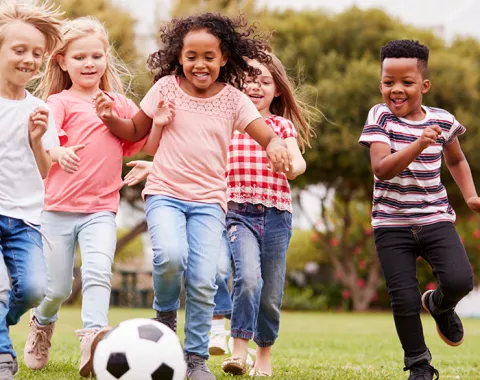Big Body Play is the act of participating in activities that are vigorous and very physical. This can include tumbling, wrestling, rolling, pulling/pushing, spinning, and any other activity that often requires risk-taking and fast movements. Frances Cutler, the author of the book Big Body Play, describes this rowdy, and sometimes bone-jarring play, as essential to the physical, mental, and emotional development of children. Children who regularly participate in Big Body Play activities are often faster and more physically fit than their peers, but also, according to the Association for the Education of Young Children (NAEYC), go on to develop stronger social-emotional intelligence and linguistic thinking than children who do not participate in Big Body Play activities. Furthermore, having the opportunity to “burn off that energy” helps children to feel calm and get better rest, while also learning to control their bodies, take risk assessments, and cooperate better with their peers.
Luckily, Big Body Play does not need a lot of bells or whistles, and it does not need to be expensive. Here are some simple ways to incorporate it into your everyday activities.
- Simple mats/ramps – supplying a soft ground surface right in your living room can encourage kids to take a few extra risks while rolling and jumping around. Add a ramp (between two and five feet long) to open the space for movement that requires a bit more strength and flexibility.
- Mini trampolines and other movement toys – just like mats and ramps, mini trampolines are easily purchased online, and can fit into even smaller rooms. It’s a great way for kids to burn a lot of energy – especially if you guide them in doing different types of jumps (two feet, one foot, bounce on knees, etc.). Movement toys can include balancing discs, sit n’ scoots, and wiggle seats.
- Sensory balls – these balls are awesome for play and sensory input. Choose ones that are sturdy enough for your kids to sit on and roll-on top of, but still light enough for them to pick up and bounce or throw. You can often choose between ones with smooth surfaces, or a variety of other textures based on your child’s comfort levels. Step n’ Balance Sensory Steps are also a fun option that are easy to store and provide instant access to Big Body Play creativity.
- Group Games: (i.e. Tug o’ War, Red Rover) – get a little old school when your kids’ friends come to visit. Provide them with a sturdy rope for a challenging game of Tug o’ War (have prizes ready for both teams regardless of if they win or lose). Or teach them one of your favorites. Red Rover is always a hit with older kids, while something like Ring Around the Rosie is perfect for the younger crowd.
- Dancing – turn on the music from your TV, laptop, or phone! Crank it up high! Dim the lights, provide some refreshments, and encourage your kids to get super silly and inventive with their best dance moves.
- Playgrounds – head out to your nearest playground and do your absolute best to not intervene (sans real danger) as your children navigate the ladders, ropes, bridges, monkey bars, swings, and slides on their own. Bring a small first aid kit (alcohol pads, band-aids, ice pack). Not because they will get hurt, but if they have a minor hic-up, showing that you are there to tend to their falls, allows them to feel safe and willing to get up and play again.
- Organized Sports – find classes near you via an internet search or by asking local parent groups via social media for recommendations. Ask your kid(s) what sport they would most like to try and go for it! Both group sports (soccer, basketball, etc.) and solo sports (tennis), provide great access to Big Body Play.
Big Body Play has enormous benefits for both older and younger kids (and for adults too)! Don’t hesitate to get a little boisterous with your kids – they will have double the fun with you participating. This also shouldn’t be a chore, make it an obvious part of your day. Enjoy, and have fun!





